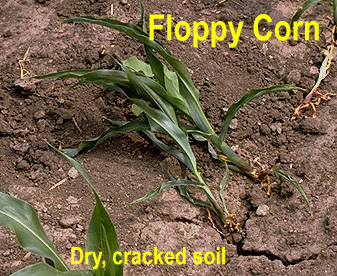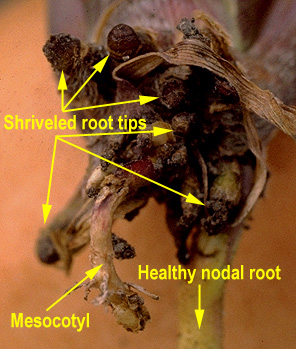Potential for Floppy Corn in Late-Planted Fields
R.L. (Bob) Nielsen ,
Agronomy Department ,
Purdue University, West Lafayette, IN
47907-1150
Internet address: rnielsen@purdue.edu
- Recently planted corn may be susceptible to root development problems
due to drying of surface soil layers.
As usual, the conversations around the tables at the Chat 'n Chew Cafe
over the weekend involved a mix of good news and bad news about the current
corn crop in Indiana. The optimists over in the corner booth were reveling over
the recent string of sunny, warm days that has finally given the growth of the
first-planted corn a kickstart. The pessimists up at the counter, though, were
worried about the effects of rapidly drying surface soil on the root
establishment of later-planted corn.
Let's recall earlier discussions on root
development in corn. The nodal (permanent) roots begin to elongate near the
crown of the seedling shortly after emergence and are distinctly visible by
growth stage V1 (one visible leaf collar). An individual set of nodal roots
forms at each stalk node below-ground plus one or more above-ground nodes. By
growth stage V6, the nodal roots should be the main root system of the plant.
The time period between growth stages V1 and V6, therefore, is critical in
determining the success of the corn crop's root establishment.
Rapid drying of the surface soil layers during this critical time period
can stunt the growth and development of the nodal root system. Warmer than
normal temperatures, coupled with strong winds, can dry the upper inch or more
of soil very quickly. Root 'buds' from any given stalk node that begin to
elongate in dry soil or in soil cracks will quickly cease growth due to
insufficient soil moisture. If the soil remains dry long enough, the root tips
may dessicate and die.
If dry surface soil and/or hot, dry weather prevail, several sets of
nodal roots may fail to form, giving rise to the rootless corn
phenomenon. Affected plants are forced to depend on the seminal roots,
seed reserves, and mesocotyl for nourishment, when normally this life support
system has already taken a backseat to the nodal root system.
 In addition to
the nutrient stress imposed on the plants by not having an adequate permanent
root system, the rootless phenomenon can eventually lead to the floppy
corn syndrome. These plants are technically not root-lodged, they are
simply broken over at the base of the stem near the crown area.
In addition to
the nutrient stress imposed on the plants by not having an adequate permanent
root system, the rootless phenomenon can eventually lead to the floppy
corn syndrome. These plants are technically not root-lodged, they are
simply broken over at the base of the stem near the crown area.
 The permanent roots will appear stubbed
off but not eaten. The tips of the roots will be dry and shriveled. These
symptoms are unlike any associated with herbicide injury or insect feeding.
Because several sets of roots may not have formed below-ground, the crown may
"appear" to be at or above the surface.
The permanent roots will appear stubbed
off but not eaten. The tips of the roots will be dry and shriveled. These
symptoms are unlike any associated with herbicide injury or insect feeding.
Because several sets of roots may not have formed below-ground, the crown may
"appear" to be at or above the surface.
The important thing to remember is that roots will not develop in dry
soil. They will not grow toward moisture. If roots are already in moist soil,
however, they may proliferate rapidly enough and appear to 'follow' moisture
down as the soil dries. Row cultivation may throw enough moist soil around the
stalks of the plants to encourage root development and provide some structural
support. However, the ultimate answer to the problem is a soaking rain before
the whole field has 'flopped'.
 Return to the the Chat 'n Chew
Cafe.
Return to the the Chat 'n Chew
Cafe.
 The Corn Growers Guidebook , a WWW
resource for corn management systems in Indiana and the eastern CornBelt.
The Corn Growers Guidebook , a WWW
resource for corn management systems in Indiana and the eastern CornBelt.
 Purdue University Agronomy Extension
WWW Home Page.
Purdue University Agronomy Extension
WWW Home Page.
 Purdue Agronomy On-Line! ,
Purdue's Agronomy Department WWW Home Page.
Purdue Agronomy On-Line! ,
Purdue's Agronomy Department WWW Home Page.
End of Document
 In addition to
the nutrient stress imposed on the plants by not having an adequate permanent
root system, the rootless phenomenon can eventually lead to the floppy
corn syndrome. These plants are technically not root-lodged, they are
simply broken over at the base of the stem near the crown area.
In addition to
the nutrient stress imposed on the plants by not having an adequate permanent
root system, the rootless phenomenon can eventually lead to the floppy
corn syndrome. These plants are technically not root-lodged, they are
simply broken over at the base of the stem near the crown area.  The permanent roots will appear stubbed
off but not eaten. The tips of the roots will be dry and shriveled. These
symptoms are unlike any associated with herbicide injury or insect feeding.
Because several sets of roots may not have formed below-ground, the crown may
"appear" to be at or above the surface.
The permanent roots will appear stubbed
off but not eaten. The tips of the roots will be dry and shriveled. These
symptoms are unlike any associated with herbicide injury or insect feeding.
Because several sets of roots may not have formed below-ground, the crown may
"appear" to be at or above the surface.